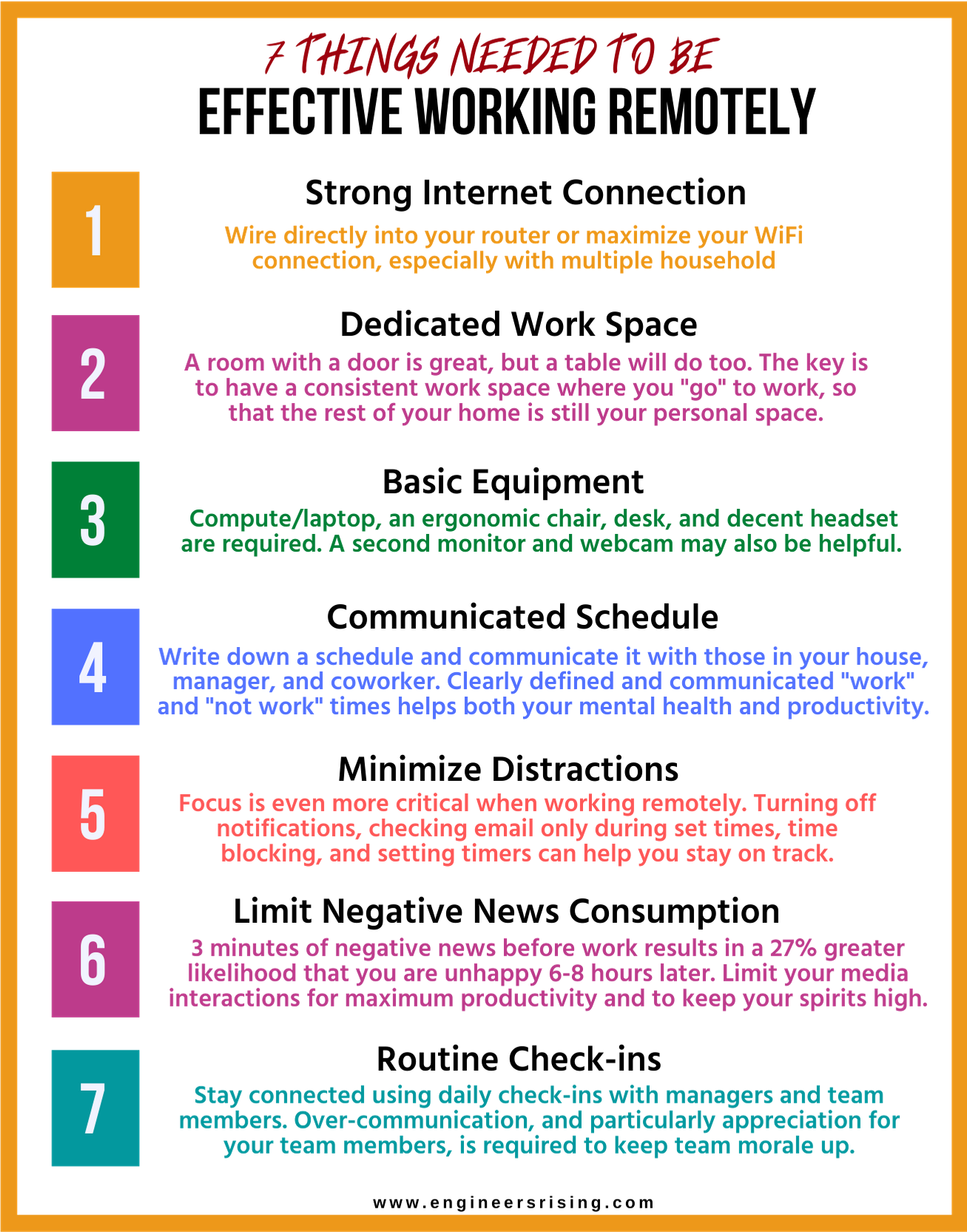The world has changed dramatically in the last week.
My family and I are currently practicing extensive social distancing at home. Schools and businesses are closed, and I’ve lost track of the number of conferences and appointments that have been canceled and rescheduled. Instacart delivered groceries minutes ago, where they left them outside without having contact with us.
For many office workers, it’s also the first time that they are being required to work full-time remotely, in some cases on very short notice.
For example, I spoke with an engineer who learned Monday night that she’d need to work from home - starting on Tuesday - due to a State Governor’s order that all non-essential businesses close effective midnight - that came in late Monday.
While working from home can seem like a dream come true, it also comes with its own set of challenges. I personally discovered many of those challenges when I transitioned from office employee to remote worker in 2018, as the founder of my own cloud-based business who also has three elementary-age children.
And when there’s little time to prepare, it can leave engineers scrambling and uncertain as to what they actually need to work from home, especially in what is anticipated to be a temporary situation.
STAY UP TO DATE ON ALL THE INFO YOU NEED TO STAY HEALTHY AND PRODUCTIVE AS AN ENGINEER WORKING FROM HOME DURING THE CORONAVIRUS! SUBSCRIBE TO GET OUR LATEST UPDATES.
Google “things you need to work from home” and you’ll find 7,050,000,000 results, often with lists of 20 or more things supposedly “required” to work from home. It’s hard to figure out what you actually need, and you likely don’t want to spend a ton of your hard-earned money to outfit a state-of-the-art home office given that that remote working may be temporary and it is too early to tell what effect the pandemic will have on engineering jobs.
This blog was written to share only the things you actually need to be productive from day 1 working from home during the pandemic, even when on short notice. You can do this all without breaking the bank or leaving home.
***Note: Some of the links in this blog are affiliate links, meaning that we receive a small commission from Amazon if you click on the link and order via the link. It does not affect the purchase price of the item from Amazon. We only recommend items that we have personally used and thank you for supporting our small business in this way if appropriate for you. Please use your own research/discretion when determining if online purchase is suitable for your own needs.***
Here are the 7 things you need to get started and be effective working remotely.
1. STRONG INTERNET CONNECTION
Working and collaborating remotely is only as good as your internet connection.
We already had a fast internet connection when I started working remotely, but still had areas of the house (and especially where I ended up in #2, which is far aware from the router) that were slow. We purchased this Apple Airport and the problem was solved.
My lessons learned for a fast internet connection are:
Use a computer hard-wired into a router if possible.
Working near the router gives you the best Wi-Fi signal.
You can enhance your Wi-Fi signal via the purchase of a Wi-Fi enhancement tool, like the Apple one mentioned above. I also understand that Amazon’s Eero or Google’s Nest Wi-Fi can do the same thing, but I haven’t personally used either.
Enhance your Wi-Fi
The Apple Airport or similar device can help you ensure a stronger Wi-Fi connection when working remotely. This is a photo of ours.
2. DEDICATED WORK SPACE
When I first began working from home, I worked on the couch, at the dining room table, and even sitting on my bed with my laptop.
While I was able to get a lot of work done this way, my back started to hurt (see #3). I also felt like I could never unplug because my laptop had invaded every room in the house. My stress levels increased because my laptop was everywhere as a visual reminder of the work not yet done.
On the advice of a peer who had worked from home for years, I finally decided to place my laptop in one room (it happened to be a spare bedroom) permanently. I go there to work, and when I’m done, I shut the door and leave the room. I even (usually) leave the phone in that room in the evenings, so I’m not tempted to do work ANYWHERE other than this room.
Within this particular room, I also eliminated any visual clutter – especially things that I can see out of the corner of my eye when I’m working - that reminds me of any home and house-type things that need to be done.
As soon as I followed that advice, my stress levels plummeted AND my productivity increased.
Even if you can’t dedicate a room, pick a space in your house that is for “work only”. Your mental health – in addition to your productivity – will thank you.
Go to work at home.
No need to be fancy, the important thing is that you have a place your work lives. This is a picture of my own setup.
3. BASIC EQUIPMENT
In the first two weeks of working remotely, I moved to several different locations, including all comfy chairs, the wooden breakfast nook chairs, the couch, and even my bed. None of these are designed for sitting on for 8+ hours of the day. As a result, my back was killing me (that took multiple chiropractor visits to fix!).
To avoid this problem for yourself – especially when you may not be able to even schedule a chiropractor appointment – invest in a decent chair if nothing else. You don’t have to spring for a $1000 Herman Miller chair, and there are plenty of chairs available for delivery that is rated for at least 8 hours of sitting. I snagged my current chair on sale from Staples after visiting the store.
Since visiting a store to purchase a chair at the moment is not currently possible for many, I would like to share this online, low-cost/high-value chair option. We actually liked this particular SPACE chair so much that we purchased a bunch of them for the entire office I previously worked in from Amazon. This same chair is still available and currently priced at a budget-friendly $160. It was also in stock for delivery at the time of writing this blog (I can’t say the same about toilet paper on Amazon). It’s adjustable, it has lumbar support, and I sat in it without back pain for 5 years.
Another low-cost/high-value item I purchased was a $30 recyclable standing desk platform.
I didn’t have a “real desk” in my spare bedroom, and I was (and still am) using a spare table. There wasn’t extra space in the room for a desk. So, I found this recyclable “standing desk” you can set on a table for about $30, and I’m actually still using it because it has worked so well. It has two tiers, and I move my laptop to the top tier when standing (all phone calls) and the bottom when sitting (deep thinking work).
The one I purchased from Amazon.com isn’t currently available, but this one is very similar, and this one is both portable and has good reviews. Both are budget-friendly at around $30.
STAY CONNECTED WITH OUR COMMUNITY OF EMPOWERED WOMEN IN ENGINEERING BY SIGNING UP FOR OUR MAILING LIST BELOW!
The other piece of equipment that I believe is a “must” when working from home is a good headset. Your office should provide this to you (and/or reimburse you for it) if you are expected to be on calls with clients often. The headphones that came with your phone often don’t produce the highest quality sound and some of them clearly share background noise with the listener.
If you’re wondering what headset I use, it is this Jabra Evolve 75. It’s not the prettiest, but I love its functionality and a more reasonable price as compared to the high-end Jabra models. The set I use is currently $270 on Amazon. The voice quality is amazing, anything but the loudest of background noise is not heard by the people you are talking to, and you can mute and unmute your own speaker at the touch of a button, which has been extremely helpful when my kids pop their heads into my workspace.
I can also connect it to more than one device at the same time: my laptop via USB and my phone via Bluetooth. If you need to purchase a headset, be advised that some of the lower-cost versions only allow one connection, so that’s something to watch out for if your work calls occur on both devices.
Some engineers will also want things like a second monitor and wireless mouse or keyboard. If you routinely record videos for work, you may also want a dedicated webcam. I use this Logitech, which you can conveniently place right on top of your laptop screen and connects via a USB port.
4. SCHEDULE (THAT IS WRITTEN DOWN AND COMMUNICATED)
When I started working from home, it was initially challenging to keep a schedule, especially since I began in the summer when the kids were home from school.
Even if you don’t have kids, creating and communicating a consistent schedule around your work will both improve your productivity and make it easy for you to create and communicate boundaries for other coworkers who are also working from home.
Write down that schedule, post it where you can see it, and share it with the residents of your home and your coworkers. You won’t be able to keep it 100% of the time, but at least it sets some boundaries (and hopefully prevents coworkers from expecting a response from you at midnight if you’re not scheduled to work them).
Even if you are required by your employer to work set hours, write down what you are planning to do during those hours, and hold yourself accountable to them.
For example:
I do my most important work first thing in the morning (before checking email or doing anything else). I protect that time block to the extent I am able. Because we have three kids also home from school, this means I need to get up early, breakfast is within easy reach, and they are expected to get it themselves (We have a 5 year old so we moved some things around for her). The kids also get unlimited morning screen time until that particular work is done.
I’ve set aside 1- 1 1/2 hours a day in the afternoon or evening to check and respond to email, and that’s it. If you send me a non-urgent email, you may not get a response for a few days, and I’m OK with that because my most important work takes priority.
I generally schedule meetings and phone calls in the afternoon where possible, which makes my “deep work” time in the morning feasible.
5. PROACTIVELY MINIMIZING DISTRACTIONS
We all know distractions are a productivity killer. Every physical or digital item you allow into your space has the potential to become a distraction.
Working remotely can introduce a higher level of distraction, especially if your kids are also home due to school closures. There’s laundry, meals, and the half-started project you walk by daily that you usually forget about when you are at work.
There’s also internet research to be done to figure out where you can actually find toilet paper in your neighborhood or online.
Add a spouse, partner, or roommates who are also working from home, and some kids who are home because the schools are closed, and you have a recipe for overwhelming distractions if you don’t take measures to counteract them.
You’ve probably already covered the basics, by disabling all but essential notifications and putting limits on when or how often you check email and social media. Not matter what your ego says about how important your work is, the reality is that unless you are a first responder, you likely do not need your work email or any social media notifications turned on when working.
You’ll check your email during the scheduled times (which have been communicated to your team per #4), so there’s simply no need for them to be constantly on
If you have kids like I do, they may already be proclaiming “I’m bored”; “I don’t want to do chores”; “I just spilled paint on the dog”; or “My sister just hit me with a light saber.” I have heard this and more from my three elementary school age children since the schools closed.
That’s why it’s critical to make every working minute matter, so you don’t have to work late into the night. Most adults need at least eight hours of sleep per night to be healthy (I need 8 ½ to be fully functional). Lack of sleep leads to a rundown immune system, which leads to illness. A pandemic is not the time to be staying up late to work!
Finding a dedicated work space helps (see #2). Once you’ve done that, double check that you’ve turned off ALL automatic notifications on your laptop and get to work.
Finally, use your phone to set a timer to give you mini deadlines throughout the day to get your work done. To do that: place your phone on silent, set the timer, and then put it either away from your desk or on a far corner of your desk so you have to physically get up to see any new notifications on your phone.
I personally was surprised at how habitual checking my phone had become, and didn’t recognize the productivity dive I was taking each time I checked it, until I moved my phone out of arm’s reach.
For big tasks, I personally like 55 minute increments with a 5 minute movement break. I set the timer for 55 minutes, focus ONLY on the specific task to be done during that time, and when my phone rings, I do 20 jumping jacks, pushups, or I dance to one upbeat song. I then repeat that process.
Even if that task isn’t done yet, I take the break and then set the timer again. It keeps my energy high and distractions at bay. You can change the timing (for example, maybe you want to give yourself a 30 minute limit for checking email), but I’ve found that this simple (and free!) method to work wonders for helping me focus.
Use a timer.
Try using your phone’s timer to help you focus. I like using 55/5, with 55 minutes for work and 5 minutes for movement break.
6. LIMIT NEGATIVE NEWS CONSUMPTION
Did you know that watching just three minutes of negative news in the morning before work has been correlated with a 27 percent greater likelihood of reporting your day as unhappy six to eight hours later (Source: THIS article at the Harvard Business Review)?
That means checking your phone for an update on the latest coronavirus restrictions either before work or first thing in the morning before doing any work is derailing a whole lot more than just your productivity.
Particularly if you are already prone to anxiety, limit your access to the news. If something is cancelled or closed, trust that you’ll be contacted via email. If you MUST check, do it once a day, preferably after you have your most important work done and at least 4 hours before you go to bed.
7. ROUTINE CHECK-INS
Working at home can be isolating.
It can also make any current communication problems you might already have in your office worse.
That’s why I recommend daily check-ins, at least at first, for teams that are new to working remotely full-time. Many offices already have an appropriate software for teleconferences, but if not, you can always get a free Zoom account for this purpose.
To be clear, the purpose of the daily check-in isn’t to have a two-hour meeting rehashing the previous day or major, specific issues. Check-in meetings should be very short; additional meetings for specific issues can be added as needed with the essential team members only.
The purpose of the check-ins is to allow team members to maintain a sense of normalcy – including trust and accountability – while working remotely. This is particularly important if team members are transitioning from mostly in-office work to all remote work. During these check-ins, team members should indicate their #1 priority for the day and share where they need help from other team members that day or week.
If you are a manager, consider adding at least one 1-on-1 weekly check-in with each individual team member per week. It’s human nature to be anxious and worried about uncertainties, and the additional 1-on-1 communication can go a long way towards maintaining normalcy, not to mention helping your team function at maximum productivity. As a remote manager, you will need to communicate more than you think is necessary to be effective.
Are you working remotely? Share your tips from your own experience below.











